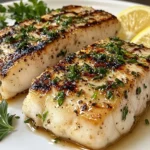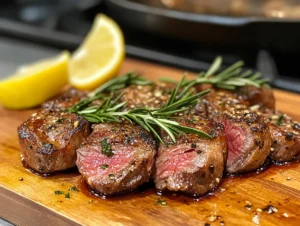Table of Contents
There’s something magical about bringing fresh-caught fish to the table – especially when it’s as magnificent as amberjack. The first time I prepared an amberjack recipe for my family, I was honestly a bit intimidated by this firm, meaty fish. But standing in my kitchen with the afternoon sun streaming through the windows, I realized this was an opportunity for culinary adventure rather than anxiety. Amberjack isn’t just another fish; it’s a celebration of coastal bounty that deserves special treatment in your kitchen.
My husband Eric caught an impressive 30-pound amberjack during a Gulf fishing trip with friends last summer, and I’ll never forget the proud look on his face when he walked through our front door with his prize. The kids gathered around, wide-eyed at the massive fish, and little Caleb immediately asked, “But Mommy, how are we gonna eat THAT?” That’s when my journey with amberjack recipes truly began – and I’m thrilled to share what I’ve learned with you.
Why You’ll Love This Amberjack Recipe
This amberjack recipe collection has become a staple in our home for so many reasons. First, despite its impressive appearance, amberjack is incredibly versatile and forgiving to cook. Even if you’re not a seafood expert, these methods will give you restaurant-quality results.
You’ll also appreciate that amberjack’s firm, meaty texture holds up beautifully to bold flavors and various cooking techniques. It’s not a delicate fish that falls apart – it stands up proudly to grilling, baking, and even blackening.
Best of all, amberjack delivers exceptional nutritional value. It’s packed with lean protein, heart-healthy omega-3 fatty acids, and essential minerals that make it as good for your body as it is delicious for your taste buds.
And let’s be honest – serving a beautiful piece of amberjack feels special. It’s the kind of meal that creates memorable dining experiences, whether you’re feeding your family on a Tuesday or entertaining friends on the weekend.
Ingredients
For Grilled Amberjack with Lemon-Herb Butter
- 4 amberjack fillets (about 6 oz each)
- 2 tablespoons olive oil
- 1 teaspoon sea salt
- 1/2 teaspoon freshly ground black pepper
- 2 cloves garlic, minced
- 1 lemon, zested and juiced
- 1/4 cup unsalted butter, softened
- 2 tablespoons fresh herbs (parsley, dill, and chives work beautifully)
- 1 teaspoon Dijon mustard
For Blackened Amberjack
- 4 amberjack fillets (about 6 oz each)
- 3 tablespoons blackening seasoning
- 2 tablespoons butter
- 1 tablespoon olive oil
- Lemon wedges for serving
For Baked Amberjack with Mediterranean Flavors
- 4 amberjack fillets (about 6 oz each)
- 1/4 cup olive oil
- 3 cloves garlic, minced
- 1 pint cherry tomatoes, halved
- 1/2 cup Kalamata olives, pitted and halved
- 1 lemon, thinly sliced
- 2 tablespoons capers, drained
- 1/4 cup fresh basil, chopped
- Salt and pepper to taste
For Coconut-Crusted Amberjack
- 4 amberjack fillets (about 6 oz each)
- 1/2 cup all-purpose flour (or almond flour for a gluten-free option)
- 2 eggs, beaten
- 1 cup unsweetened coconut flakes
- 1/4 cup panko breadcrumbs
- 1 teaspoon garlic powder
- 1/2 teaspoon paprika
- Salt and pepper to taste
- 3 tablespoons coconut oil for frying
For Amberjack Ceviche
- 1 pound fresh amberjack, cut into 1/2-inch cubes
- 3/4 cup fresh lime juice
- 1/4 cup fresh lemon juice
- 1/2 red onion, finely diced
- 1 jalapeño, seeded and minced
- 1/2 cup cucumber, diced
- 1 mango, diced
- 1/4 cup fresh cilantro, chopped
- 1 tablespoon olive oil
- Salt to taste
- Tortilla chips for serving
Substitution tip: If you can’t find amberjack, other firm white fish like mahi-mahi or grouper work well as alternatives in these recipes.
Timing
Preparation Time: 15-20 minutes
Cook Time: Varies by method (10-25 minutes)
Total Time: 25-45 minutes
Yield: 4 servings
This amberjack recipe collection offers significantly faster cooking times than many other fish preparations – about 30% quicker than traditional fish stews or complicated sauce-based dishes. Perfect for both weeknight dinners and special occasions!
Step-by-Step Instructions
Grilled Amberjack with Lemon-Herb Butter
Step 1: Prepare the Compound Butter
In a small bowl, combine the softened butter, lemon zest, one tablespoon of lemon juice, minced garlic, chopped herbs, and Dijon mustard. Mix well, then set aside. (This can be made ahead and refrigerated – just bring to room temperature before serving.)
Step 2: Prepare the Fish
Pat the amberjack fillets dry with paper towels. Brush both sides with olive oil and season generously with salt and pepper.
Step 3: Grill the Fish
Preheat your grill to medium-high heat (about 400°F). Oil the grates well to prevent sticking. Grill the amberjack for 4-5 minutes per side, or until the internal temperature reaches 145°F and the fish flakes easily with a fork.
Olivia’s Tip: Amberjack is a firm fish that holds up beautifully on the grill. Don’t flip it too early – let those gorgeous grill marks develop before turning!
Step 4: Serve
Transfer the grilled amberjack to plates and immediately top each fillet with a generous dollop of the lemon-herb butter, allowing it to melt over the hot fish. Serve with additional lemon wedges.
Blackened Amberjack
Step 1: Season the Fish
Generously coat each amberjack fillet with blackening seasoning, pressing it in to adhere well.
Step 2: Prepare the Pan
Heat a cast-iron skillet over high heat until it’s smoking hot. Add the butter and oil.
Step 3: Blacken the Fish
Carefully place the seasoned fillets in the hot skillet. Cook for about 2-3 minutes per side for a medium-rare to medium doneness, or 3-4 minutes per side for more well-done fish.
Olivia’s Tip: This method creates some smoke, so be sure to turn on your vent fan! The smoky flavor is worth it, though – it’s Caleb’s favorite way to eat fish now that he’s discovered his “spicy” palate!
Step 4: Rest and Serve
Let the blackened amberjack rest for 2-3 minutes before serving with lemon wedges to cut through the spice.
Baked Amberjack with Mediterranean Flavors
Step 1: Preheat and Prepare
Preheat your oven to 375°F. In a baking dish, arrange the amberjack fillets in a single layer.
Step 2: Create the Mediterranean Topping
In a bowl, combine olive oil, garlic, cherry tomatoes, olives, capers, and a pinch of salt and pepper. Mix well.
Step 3: Assemble and Bake
Pour the Mediterranean mixture over the fish. Lay lemon slices on top. Bake for 15-20 minutes, until the fish is opaque and flakes easily.
Step 4: Finish and Serve
Remove from the oven, sprinkle with fresh basil, and serve immediately.
Olivia’s Tip: This is a wonderful make-ahead dish! Prepare everything up to the baking step, refrigerate, and then pop it in the oven when you’re ready to eat.
Cooking Tips
The secret to a perfect amberjack recipe lies in not overcooking the fish. Unlike more delicate species, amberjack is meaty and firm, but it can become tough if cooked too long. Aim for an internal temperature of 145°F for the best texture.
Fresh amberjack should have a clean, oceanic smell – never fishy. If you’re buying fresh, look for clear eyes (if the head is attached) and firm flesh that springs back when touched.
For grilled amberjack recipes, keep the skin on during cooking to help protect the flesh from drying out. You can easily remove it before serving if preferred.
When working with amberjack, particularly for ceviche, it’s crucial to use the freshest fish possible. I recommend building a relationship with a local fishmonger who can tell you exactly when their seafood arrived.
A little acidity goes a long way with amberjack. Whether it’s lemon, lime, or a splash of vinegar, that brightness beautifully balances the rich flavor of this magnificent fish.
A Memorable Amberjack Adventure
I’ll never forget the summer evening when we invited our neighbors over for an impromptu dinner featuring grilled amberjack. As the sun set over the Blue Ridge Mountains, casting an amber glow across our back deck (fitting for amberjack, right?), the aroma of the herb butter melting over the hot fish filled the air.
Our neighbor Jim, a self-proclaimed “fish skeptic,” took one bite and his eyes widened. “This doesn’t taste like fish,” he exclaimed, somewhat confused. His wife Sarah laughed and said, “That’s because it tastes like actual good fish, not the frozen stuff you’re used to!” By the end of the night, I was writing down my amberjack recipe on the back of an envelope for them to take home.
That night reminded me that good food isn’t just about feeding people – it’s about creating experiences and changing perspectives, one delicious bite at a time.
Nutritional Information
Per Serving (6 oz grilled amberjack fillet with lemon-herb butter):
- Calories: 290
- Protein: 36g
- Fat: 15g
- Saturated Fat: 6g
- Carbohydrates: 2g
- Fiber: 0g
- Sodium: 380mg
Amberjack is an excellent source of lean protein, providing about 36 grams per 6-ounce serving. It’s also rich in essential omega-3 fatty acids, which support heart and brain health.
This powerful fish delivers impressive amounts of vitamin B12, niacin, and minerals such as selenium and potassium. These nutrients support energy metabolism, immune function, and help protect cells from oxidative damage. According to the American Heart Association, eating fish like amberjack twice a week can significantly improve your cardiovascular health. You can learn more about the health benefits of eating seafood at seafood nutrition.
Healthier Alternatives
If you’re watching your calories or following a specific dietary plan, these amberjack recipes can be easily modified:
For a lower-fat version of the grilled amberjack, replace the butter in the compound butter with Greek yogurt or a plant-based butter alternative. You’ll still get wonderful flavor with significantly less saturated fat.
The Mediterranean baked amberjack is naturally Paleo and Whole30 friendly, making it perfect for those following clean eating protocols.
For gluten-free diners, the coconut-crusted amberjack works beautifully with almond flour instead of all-purpose flour, and you can use gluten-free panko crumbs.
If you’re watching sodium, reduce the salt in all recipes and amp up fresh herbs and citrus zest for flavor without the added sodium.
Serving Suggestions
I love serving grilled amberjack with a side of bacon-wrapped little smokies for a fun appetizer spread when entertaining. For the main course, this hearty fish pairs beautifully with lighter sides to create balance on your plate.
For a summer meal, serve your amberjack alongside grilled corn on the cob and a bright arugula salad dressed simply with lemon juice and olive oil.
In cooler months, creamy polenta or roasted rosemary potatoes complement the meaty texture of the fish perfectly.
For a tropical-inspired meal, pair the coconut-crusted amberjack with coconut rice and fresh mango salsa for a cohesive theme your family will love.
Wine enthusiasts will appreciate how amberjack stands up to bolder white wines – try a Viognier or an unoaked Chardonnay that won’t get lost against the fish’s rich flavor.
Common Mistakes to Avoid
Overcooking: The number one amberjack recipe mishap is cooking it too long! This fish is best when still slightly translucent in the very center – it will continue cooking after you remove it from the heat.
Under-seasoning: Because amberjack is a meaty fish, it can handle and actually needs bold flavors. Don’t be shy with your seasonings.
Poor quality fish: For amberjack recipes, especially preparations like ceviche where the fish isn’t fully cooked, quality is absolutely crucial. This isn’t the place to skimp – find the freshest fish possible.
Skipping the rest: After cooking, let your amberjack rest for a few minutes before serving. This allows the juices to redistribute throughout the fish, resulting in a more succulent final product.
Ignoring doneness cues: Rather than strictly following cooking times, look for visual cues – the fish should be opaque but still moist, and it should flake easily with gentle pressure from a fork.
Storing & Reheating Tips
Cooked amberjack will keep in the refrigerator for up to 2 days when stored in an airtight container. I recommend laying a paper towel under and over the fish to absorb excess moisture and preserve the texture.
For the best reheating results, warm amberjack gently. High heat will quickly dry out the fish. For grilled or baked preparations, cover with foil and heat in a 275°F oven until just warmed through (about 10-15 minutes).
Blackened amberjack actually reheats beautifully in a skillet over medium-low heat with a small pat of butter to refresh the exterior.
Leftover amberjack also makes incredible fish tacos the next day! Flake the cold fish, warm it slightly, and serve with fresh slaw and a squeeze of lime for an entirely new meal.
Freezing cooked amberjack isn’t ideal as the texture suffers significantly, but if necessary, use it within one month and thaw overnight in the refrigerator.
FAQs
What does amberjack fish taste like?
Amberjack has a clean, rich flavor that’s milder than you might expect for such a large fish. Its taste is often compared to mahi-mahi or tuna, with a buttery quality that makes it incredibly versatile in recipes for amberjack. The flesh is firm and meaty with large flakes, making it substantial enough to satisfy even those who don’t typically enjoy seafood.
Where can I find amberjack for these recipes?
Amberjack is most commonly found fresh in coastal areas, particularly along the Gulf of Mexico and the southeastern Atlantic coast. Look for it at speciality seafood markets or ask your local fishmonger if they can order it. If fresh isn’t available, high-quality frozen amberjack works well for most cooking methods except ceviche, where fresh is essential. Some online seafood retailers also ship fresh-caught amberjack overnight.
Can I use these amberjack fish grilled recipes for other types of fish?
Absolutely! While these recipes are optimized for amberjack’s unique texture and flavor profile, they adapt well to other firm, meaty fish like mahi-mahi, grouper, or halibut. For more delicate fish, you may need to adjust cooking times downward. The tortilla quiche bake recipe on my site works nicely alongside any of these fish dishes for a complete meal.
Final Thoughts
There’s something deeply satisfying about mastering a perfect amberjack recipe – the kind that makes you feel like you’ve unlocked a culinary secret. Whether you’re grilling it with that herbaceous lemon butter, blackening it to spicy perfection, or letting it “cook” in citrus for a refreshing ceviche, amberjack rewards your attention with incredible flavor and texture.
What I love most about cooking amberjack is how it connects us to coastal traditions and the bounty of our waters. Even here in the mountains of North Carolina, preparing this magnificent fish brings a taste of seaside living to our table. It reminds us that good food crosses boundaries and brings experiences from afar right into our homes.
I hope these amberjack recipes inspire you to step outside your seafood comfort zone, whether you’re an experienced cook or just beginning your culinary journey. Trust me when I say that the first time you see your family’s eyes light up as they taste perfectly prepared amberjack, you’ll understand why this fish holds a special place in my kitchen and my heart.
Try one of these recipes tonight and let me know which becomes your family’s favorite! I’d love to hear your amberjack stories in the comments below.
Print
Amberjack recipe: 5 Best Ways to Cook This Tasty Fish
- Total Time: 45 minute
- Yield: 4 servings 1x
- Diet: Gluten Free
Description
Looking for delicious ways to cook amberjack? Try these 5 best amberjack recipes that will impress your taste buds. Discover mouthwatering tips today!
Ingredients
For Grilled Amberjack with Lemon-Herb Butter
- 4 amberjack fillets (about 6 oz each)
- 2 tablespoons olive oil
- 1 teaspoon sea salt
- 1/2 teaspoon freshly ground black pepper
- 2 cloves garlic, minced
- 1 lemon, zested and juiced
- 1/4 cup unsalted butter, softened
- 2 tablespoons fresh herbs (parsley, dill, and chives work beautifully)
- 1 teaspoon Dijon mustard
For Blackened Amberjack
- 4 amberjack fillets (about 6 oz each)
- 3 tablespoons blackening seasoning
- 2 tablespoons butter
- 1 tablespoon olive oil
- Lemon wedges for serving
For Baked Amberjack with Mediterranean Flavors
- 4 amberjack fillets (about 6 oz each)
- 1/4 cup olive oil
- 3 cloves garlic, minced
- 1 pint cherry tomatoes, halved
- 1/2 cup Kalamata olives, pitted and halved
- 1 lemon, thinly sliced
- 2 tablespoons capers, drained
- 1/4 cup fresh basil, chopped
- Salt and pepper to taste
For Coconut-Crusted Amberjack
- 4 amberjack fillets (about 6 oz each)
- 1/2 cup all-purpose flour (or almond flour for a gluten-free option)
- 2 eggs, beaten
- 1 cup unsweetened coconut flakes
- 1/4 cup panko breadcrumbs
- 1 teaspoon garlic powder
- 1/2 teaspoon paprika
- Salt and pepper to taste
- 3 tablespoons coconut oil for frying
For Amberjack Ceviche
- 1 pound fresh amberjack, cut into 1/2-inch cubes
- 3/4 cup fresh lime juice
- 1/4 cup fresh lemon juice
- 1/2 red onion, finely diced
- 1 jalapeño, seeded and minced
- 1/2 cup cucumber, diced
- 1 mango, diced
- 1/4 cup fresh cilantro, chopped
- 1 tablespoon olive oil
- Salt to taste
- Tortilla chips for serving
Instructions
In a small bowl, combine the softened butter, lemon zest, one tablespoon of lemon juice, minced garlic, chopped herbs, and Dijon mustard. Mix well, then set aside. (This can be made ahead and refrigerated – just bring to room temperature before serving.)
Pat the amberjack fillets dry with paper towels. Brush both sides with olive oil and season generously with salt and pepper.
Preheat your grill to medium-high heat (about 400°F). Oil the grates well to prevent sticking. Grill the amberjack for 4-5 minutes per side, or until the internal temperature reaches 145°F and the fish flakes easily with a fork.
Olivia’s Tip: Amberjack is a firm fish that holds up beautifully on the grill. Don’t flip it too early – let those gorgeous grill marks develop before turning!
Transfer the grilled amberjack to plates and immediately top each fillet with a generous dollop of the lemon-herb butter, allowing it to melt over the hot fish. Serve with additional lemon wedges.
Generously coat each amberjack fillet with blackening seasoning, pressing it in to adhere well.
Heat a cast-iron skillet over high heat until it’s smoking hot. Add the butter and oil.
Carefully place the seasoned fillets in the hot skillet. Cook for about 2-3 minutes per side for a medium-rare to medium doneness, or 3-4 minutes per side for more well-done fish.
Olivia’s Tip: This method creates some smoke, so be sure to turn on your vent fan! The smoky flavor is worth it, though – it’s Caleb’s favorite way to eat fish now that he’s discovered his “spicy” palate!
Let the blackened amberjack rest for 2-3 minutes before serving with lemon wedges to cut through the spice.
Preheat your oven to 375°F. In a baking dish, arrange the amberjack fillets in a single layer.
In a bowl, combine olive oil, garlic, cherry tomatoes, olives, capers, and a pinch of salt and pepper. Mix well.
Pour the Mediterranean mixture over the fish. Lay lemon slices on top. Bake for 15-20 minutes, until the fish is opaque and flakes easily.
Remove from the oven, sprinkle with fresh basil, and serve immediately.
- Prep Time: 20 minutes
- Cook Time: 25 minutes
- Category: Main Dish
- Method: Grilling
- Cuisine: American
Nutrition
- Serving Size: 6 oz
- Calories: 290
Keywords: amberjack recipe, amberjack recipes, recipes for amberjack, amberjack fish grilled recipe, how to cook amberjack, fresh amberjack, blackened amberjack, baked amberjack, amberjack ceviche, lemon herb butter fish


